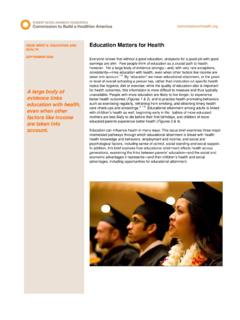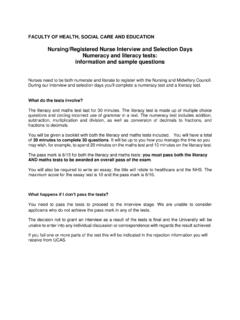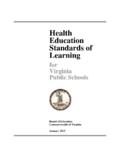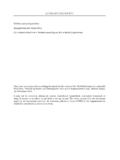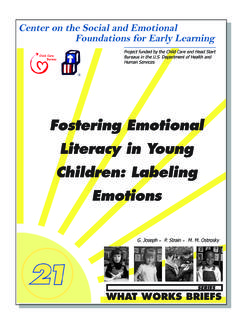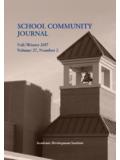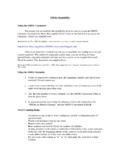Transcription of Health literacy : The solid facts
1 Health literacy The solid facts Editors: Ilona Kickbusch, J rgen M. Pelikan, Franklin Apfel & Agis D. Tsouros ABSTRACT. This publication makes the case for policy action to strengthen Health literacy . Evidence, including the results of the European Health literacy Survey, is presented that supports a wider and relational whole-of-society approach to Health literacy that considers both an individual's level of Health literacy and the complexities of the contexts within which people act. The data from the European Health literacy Survey show that nearly half the Europeans surveyed have inadequate or problematic Health literacy . Weak Health literacy skills are associated with riskier behaviour, poorer Health , less self-management and more hospitalization and costs. Strengthening Health literacy has been shown to build individual and community resilience, help address Health inequities and improve Health and well-being.
2 Practical and effective ways public Health and other sectoral authorities and advocates can take action to strengthen Health literacy in a variety of settings are identified. Specific evidence is presented for educational settings, workplaces, marketplaces, Health systems, new and traditional media and political arenas. Keywords Consumer Health information Decision making Health literacy Health management and planning Health policy Social determinants of Health ISBN: 978 92 890 00154. Address requests about publications of the WHO Regional Office for Europe to: Publications WHO Regional Office for Europe UN City, Marmorvej 51. DK-2100 Copenhagen , Denmark Alternatively, complete an online request form for documentation, Health information, or for permission to quote or translate, on the Regional Office web site ( ). World Health Organization 2013. All rights reserved. The Regional Office for Europe of the World Health Organization welcomes requests for permission to reproduce or translate its publications, in part or in full.
3 The designations employed and the presentation of the material in this publication do not imply the expression of any opinion whatsoever on the part of the World Health Organization concerning the legal status of any country, territory, city or area or of its authorities, or concerning the delimitation of its frontiers or boundaries. Dotted lines on maps represent approximate border lines for which there may not yet be full agreement. The mention of specific companies or of certain manufacturers' products does not imply that they are endorsed or recommended by the World Health Organization in preference to others of a similar nature that are not mentioned. Errors and omissions excepted, the names of proprietary products are distinguished by initial capital letters. All reasonable precautions have been taken by the World Health Organization to verify the information contained in this publication. However, the published material is being distributed without warranty of any kind, either express or implied.
4 The responsibility for the interpretation and use of the material lies with the reader. In no event shall the World Health Organization be liable for damages arising from its use. The views expressed by authors, editors, or expert groups do not necessarily represent the decisions or the stated policy of the World Health Organization. Text editing: David Breuer Cover and inside design: Christophe Lanoux, Paris, France Layout: Phoenix Design Aid Cover photos from left to right: World Health Organization/Leo Weakland; World Health Organization/Connie Petersen; World Health Organization;. World Health Communications Associates Contents iv vi 1. A. Making the case for investing in strengthening Health 3. 1 European Health literacy 4. 2 Health literacy a key determinant of 7. Example: noncommunicable 12. 3 Limited Health literacy an underestimated problem and equity 15. Example: migrants and 19. 4 Health literacy builds resilience among individuals and 22.
5 Example: Netherlands Alliance for Health 24. B. Taking action to create and strengthen Health literacy friendly 26. 5 Attributes of Health -literate 28. 6 Health literacy is a key attribute of a healthy 29. 7 Attributes of Health literacy friendly 31. 8 Educational 35. 9 Marketplace and community 40. 10 Workplace 44. 11 Health care 49. Example: adherence to 54. Example: programmes for self-managing chronic 56. 12 Media and 59. 13 Social media and mobile 63. C. Developing policies for Health literacy at the local, national and European Region 68. iii Foreword The WHO solid facts series was launched 15 years ago of Health status along with age, income, employment as an accessible source of intelligence on important status, education level and race or ethnic group. Never- and promising public Health topics deemed worthy of theless, although understanding of literacy and Health more policy attention and action.
6 It has two purposes. literacy as critically important determinants of Health First, it aims to distil the best available evidence on continues to grow, they remain neglected areas of pub- these topics based on often-complex scientific stud- lic Health action and research. This publication aims to ies and reviews. Second, it identifies policy implica- help to change this situation. tions and action points that could convert these ideas into realities. Importantly, in addressing these goals, To this end, this publication provides a concise over- the solid facts series has also appraised the strength view of evidence on Health literacy . Most evidence, until of available evidence and identified where research recently, has come from the United States of America and more solid facts are needed. Distilling evidence is and mainly focuses on people's functional Health lit- especially challenging for cutting-edge public Health eracy (people's ability to read and understand basic concepts and the need to attract the attention of deci- Health -related information) and the management of sion-makers.
7 The strength and the extent of the avail- chronic diseases. The European Health literacy Survey, able evidence may vary depending on the subject area, summarized here, has generated a rich new source of setting, Health system or methods applied. high-quality data on the comprehensive Health literacy of general populations that enables comparisons both Several factors make Health literacy a compelling and within and between countries and has made major timely topic in the solid facts series. literacy and Health inequities visible. Importantly, the European Health Lit- literacy are fundamental components of pursuing eracy Survey tools can serve as a basis for strengthening Health and well-being in modern society. As societies capacity to measure how the many promising interven- grow more complex and people are increasingly bom- tions described here may affect population Health . barded with Health information and misinformation and confront complex Health care systems, becom- This publication emphasizes information about prac- ing a Health -literate person has become a growing tical and effective ways public Health and other sec- challenge.
8 Importantly, we now understand that poor toral authorities and advocates are taking action to Health literacy adversely affects people's Health . literacy strengthen people's Health literacy . It especially focuses has been shown to be one of the strongest predictors on the Health literacy friendliness of the various iv Foreword settings in which people live, play and work. In doing various sectors and settings. Although much remains so, it remains well grounded in the values and principles to be learned, especially about the effectiveness and put forward by the Ottawa Charter for Health Promo- efficiency of interventions in various settings, such as tion. We hope the book will be used as a tool for spread- mass media and social media, growing European and ing awareness, stimulating debate and research and, global studies, surveys and experience provide a rich above all, for informing policy development and action.
9 And promising evidence base on which to draw. Health literacy is a key dimension of Health 2020, the Finally, a special word of thanks is given to the editorial European Health policy framework adopted by Mem- team for the effective way they drove and coordinated ber States in 2012. Health literacy is both a means the whole preparation process and for their excellent and an outcome of actions aimed at promoting the editorial work. empowerment and participation of people in their communities and of people in their Health care. Tak- Zsuzsanna Jakab ing action to enhance Health literacy provides a unique WHO Regional Director for Europe platform for the Health sector and its own organiza- tions and professionals to demonstrate their leadership capacity. As described here, addressing Health literacy Note of caution requires a whole-of-society approach many sectors, settings and actors need to work together to improve Although much can be learned from the activities of oth- the Health literacy of individuals and communities and ers, this guide is not promoting the wholesale adoption of any policy or programme intervention.
10 Policies are to make environments easier to navigate in support of subject to political systems and actors and require under- Health and well-being. standing the context in which they are to effect change. Any planned programme intervention should also rec- This book is the result of a systematic and compre- ognize the potential effect of cultural differences on the communication and understanding of Health informa- hensive effort to review scientific and experiential tion. Native language, socioeconomic status, gender, race evidence and to identify implications for policy and and ethnicity along with mass culture news publishing, interventions, drawing on the expertise, suggestions advertising, marketing, and the plethora of Health infor- mation sources available through electronic channels . and inputs of individuals from many academic cen- all influence the choice of Health literacy interventions. tres and disciplines as well as frontline practitioners in v Contributors Thomas Abel J rg Haslbeck University Berne Institute of Social and Preventive Careum Foundation, Zurich, Switzerland Medicine, Berne, Switzerland Maged N.










